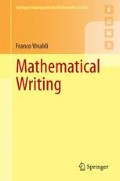Abstract
We develop some specific writing skills: choosing appropriate terms, adopting a coherent notation, writing neat formulae. We learn how to mix words and symbols in concrete small-scale tasks, such as writing a definition or introducing a new concept. The final section deals with the challenges of making a synthesis of complex material.
Access this chapter
Tax calculation will be finalised at checkout
Purchases are for personal use only
Notes
- 1.
This terminology is due to Blaise Pascal (French: 1623–1662).
- 2.
Physicists use Greek letters for subscripts and superscripts.
- 3.
Bernhard Riemann (German: 1826–1866).
- 4.
Abbreviation for the Latin id est, meaning ‘that is’.
Author information
Authors and Affiliations
Corresponding author
Rights and permissions
Copyright information
© 2014 Springer-Verlag London
About this chapter
Cite this chapter
Vivaldi, F. (2014). Writing Well. In: Mathematical Writing. Springer Undergraduate Mathematics Series. Springer, London. https://doi.org/10.1007/978-1-4471-6527-9_6
Download citation
DOI: https://doi.org/10.1007/978-1-4471-6527-9_6
Published:
Publisher Name: Springer, London
Print ISBN: 978-1-4471-6526-2
Online ISBN: 978-1-4471-6527-9
eBook Packages: Mathematics and StatisticsMathematics and Statistics (R0)

